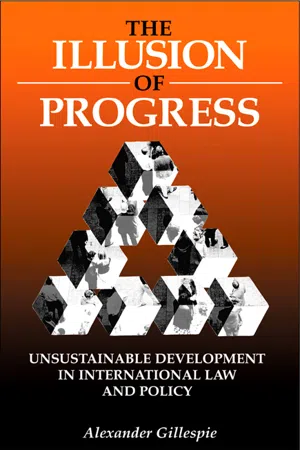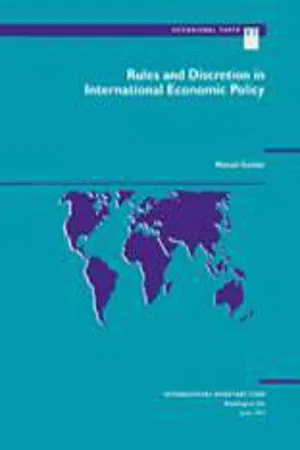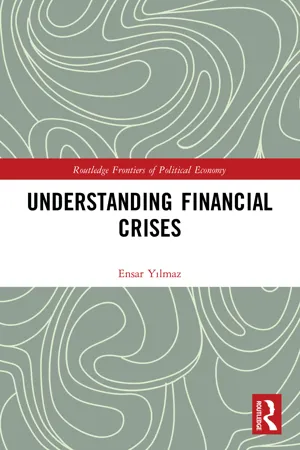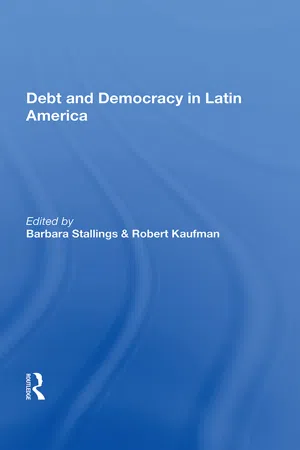Geography
Debt Crisis
A debt crisis refers to a situation where a government, corporation, or country is unable to meet its financial obligations, often resulting in default or the need for a bailout. This can lead to economic instability, currency devaluation, and social unrest. Debt crises can have significant geographical implications, impacting trade, investment, and development within and across regions.
Written by Perlego with AI-assistance
Related key terms
Related key terms
1 of 4
Related key terms
1 of 3
4 Key excerpts on "Debt Crisis"
- eBook - ePub
The Illusion of Progress
Unsustainable Development in International Law and Policy
- Alexander Gillespie(Author)
- 2014(Publication Date)
- Routledge(Publisher)
5 Debt DOI: 10.4324/9781849776226-5The Debt Crisis and Sustainable Development
The international indebtedness of sovereign countries is not a new phenomenon.1 However, the Debt Crisis, which is made up of bilateral debt (country to country), multi-lateral debt (international institution to country) and commercial debt (financial institution to country), of the 1980s and 1990s is much larger, with greater implications, than earlier foreign debts. Modern debt problems developed in the 1970s when there was a vast amount of money in circulation for Western governments and banks to lend.2 Many Southern countries took advantage of this and borrowed heavily. The money was spent on weapons, large-scale conventional development ideas, increased prices for international commodities (such as oil) or simply squandered by corrupt governments.3The possibility of a major Debt Crisis at the end of the 20th century was foreseen by the Pearson Commission in 19694 and the first Brandt Commission in 1980.5 Their predictions materialized in 1982 when interest rates rose dramatically, as did the prices of a few important foreign commodities such as oil. Further, the value of the commodities that the Southern countries produced for the industrialized world collapsed.6 Suddenly, the debts that these countries had incurred earlier could not be repaid.Since 1982 it has been estimated that over US$50 billion per annum has been leaving debt-ridden Southern countries for Western coffers. In 1999, the total debt was reported as being above US$1.9 trillion.7 The debtor countries as a group began the 1990s 61 per cent further in debt than they were in 1982.8 Moreover, the severely indebted low-income countries often pay more to their creditors than they receive (in terms of aid and new loans). Sub-Saharan Africa has a total debt of US$212 billion and paid an annual average of US$10.7 billion on debt service between 1990 and 1994 – substantially more than the US$9 billion which UNICEF estimated was needed for health, nutrition, family planning and education. Accordingly, it is not surprising to find that most of the citizens of sub-Saharan Africa are 20 per cent worse off in real terms than when they obtained independence 30 years ago, and every year they are getting poorer. Additionally, Latin Americans have seen their standard of living fall by at least 10 per cent since the Debt Crisis began.9 - Manuel Guitián(Author)
- 1992(Publication Date)
- INTERNATIONAL MONETARY FUND(Publisher)
III The International Debt Crisis: What Have We Learned?
“Let us live in as small a circle as we will, we are either debtors or creditors before we have had time to look round.”GOETHEThe 1980s will almost certainly go down in economic history as the decade of the international Debt Crisis, a period during which the debt-servicing difficulties of the developing world became a virtually constant feature of the international economic scene. Since the crisis erupted, much has been done to redress those difficulties, though a definitive resolution to the indebtedness problems has remained elusive.A good amount has been written about the Debt Crisis since its abrupt entrance onto the international stage in August 1982, with the announcement by Mexico of its inability to continue servicing its external debt obligations.36 The bulk of this literature has focused on the genesis and development of the Debt Crisis,37 proposals for its resolution,38 and the examination of analytical issues in external debt management as well as of a multiplicity of financing modalities and techniques.39 This section does not add to the variety of these topics so much as develop a number of essential lessons from the protracted struggle the international economy has been waging with the obdurate problems of external indebtedness. One significant insight gained from the evolution of the debt strategy is the difficult balance between national autonomy and the need for international rules.In order to lay out these lessons, it is first necessary to go briefly into the history of the past two decades. This is well-trodden ground, but when approached from a new perspective it reveals the need for balance between rules and discretion. This historical setting also provides the canvas for a stylized sketch of the debt strategy in its various phases. This sketch is followed by a summary outline of the role of the International Monetary Fund and the adaptations made to the institution’s policies and procedures in response to the evolution of the debt strategy. Finally, a number of critical lessons are drawn that should help the international economic system cope with similar problems in the future. The section concludes with a few final observations about the Debt Crisis and the need for certain basic norms of behavior.- eBook - ePub
- Ensar Y?lmaz(Author)
- 2020(Publication Date)
- Routledge(Publisher)
2Debt accumulation
2.1 IntroductionEconomists generally regard debt as a beneficial instrument that allows money to move from where it is least needed to where it is most needed by borrowers. Hence the deepening of national and international credit markets is thought to increase growth, since it makes it possible for more individuals to borrow from a bigger loan market at appropriate rates of interest. However, whenever a financial crisis occurs, debt turns out to be a problem, thus turning from a ladder into a chute. Hence in recent years the dynamics of debt and its relation with crises has become a much more important issue of economics.During the global crisis period that started in 2007, a large number of defaults on mortgages occurred in the US. Financial institutions, especially investment banks, could not bear these defaults. Along with the contagion of defaults, banks with liquidity problems could not continue to lend, hence it spreading to the rest of the economy. Governmental rescues increased public debt as well. This also caused fears to spread about the solvency of sovereign debts of some countries in Europe, ending with Greece’s collapse. Therefore, debt seems to have been both a cause and an outcome of the crisis.However, until the Global Recession, in the mainstream economic models, debt was not regarded as an issue that could trigger a sequence of problems, hence it was not incorporated into these models. The main rationale behind this was that borrowers and lenders canceled each other out at the level of the economy, thus every dollar owed by someone was also owed to someone. Hence the incorporation of debt into economic analysis seemed trivial. However, we learn each time from austere times (during crises) that debt is critical in terms of triggering the problems and their deepening. Therefore, debt is a more complex issue and not a simple zero-sum game. Economists have started to deal with new complications by including debt in their economic models such as heterogeneity between debtors and creditors and discontinuity arising from collapse in economic relations. - eBook - ePub
- Barbara Stallings(Author)
- 2019(Publication Date)
- Routledge(Publisher)
A Political-Economic Overview of the Debt CrisisPassage contains an image
1The Latin American Debt Problem: Anatomy and Solutions
Rudiger DornbuschThe Latin American Debt Crisis now is six years old and growing. When Mexican debts trade at 50 cents on the dollar, and those of Peru at less than a dime, the Debt Crisis is obviously unresolved. Far from improving their creditworthiness, the debtors are falling behind. Debt ratios are far above the 1982 level, and debtor countries’ economies are showing the strains of debt service in extremely high inflation, a deep drop in income, and an unsustainable cutback of investment. The debtors cannot afford to pay, nor can they afford to walk out on the system.On the side of creditors, reserves are built up to provide a cushion against potential losses. In the meantime, creditor banks are unanimous in their reluctance to continue lending in a situation where the debts are obviously deteriorating. Increasingly, the World Bank is filling the gap left by the debtor countries’ inability to pay and the banks’ unwillingness to lend. Former Treasury Secretary Baker’s “muddling through” remains the Reagan administration’s strategy, a treadmill of pretense and make believe in which both debtors and creditors are falling behind. There is a major public interest in changing the course and breaking the deadlock.This chapter briefly reviews the origins of the Debt Crisis, then identifies the present dilemmas and recommends interest recycling as a policy that involves fair burden sharing and provides the best chance for all parties to come out ahead in what is presently a negative sum game.Origins of the Debt Crisis
Debt crises are common in a broader historical perspective.1
Index pages curate the most relevant extracts from our library of academic textbooks. They’ve been created using an in-house natural language model (NLM), each adding context and meaning to key research topics.
Explore more topic indexes
Explore more topic indexes
1 of 6
Explore more topic indexes
1 of 4



